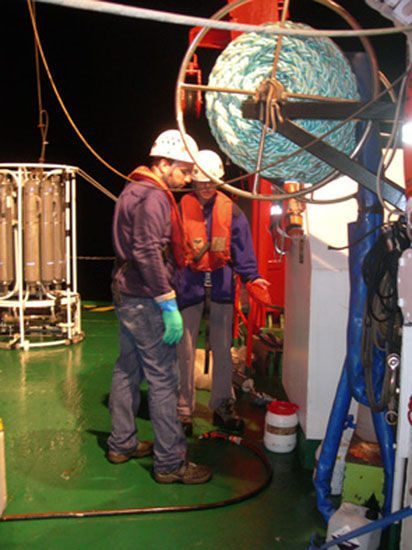You are here
Cañón de Creus Campaign - September 2009 - CSIC # Message 3
Message 3
Although it may not seem new, it is indeed that the weather keeps favoring us at this time of year at Cap Creus. The activities are still frantic onboard, without respite to daydream or get bored. The day starts abruptly very early in the morning with a series of samples collected with dragline scrapers. In some cases there is such a large amount of mud that it prolongs the work on the deck for almost an hour per sample, since we have to find the organisms within the mud.
Some of our workmates already went to bed since the activities onboard do not stop, and we have to prepare the ROV for its first immersion of the day at 7 in the morning. Tired and a little bit weary of so much mud, we decide to conclude the work at 4 in the morning, and we take a break for a few hours.
Todays first ROV images show us the platform bottoms between Cap Creus and the submarine canyon. The 100 to 120 m deep bottoms contain some filtering organism communities that are actually amazing due to their level of preservation, despite the antrophic activities in the area. Unfortunately, this does not occur on the entire platform, but there are some places almost one kilometer long where the gorgonians, alcyonarians, and bryozoans proliferate and configure a rich and diverse sea landscape. Between the ROV immersions make use of the time by collecting samples with the drag net, and to identify the species appearing in the video images with certainty.
We start other activities in the afternoon, and we prepare the zooplankton net. Its function is collecting the little planktonic animals near the bottom. It is a net that in the fishing field could be considered handmade, since these tasks usually use nets with sophisticated electronic and mechanical systems. But this equipment can not be used to collect plankton near the bottom since there is a high risk of being destroyed by the rocks. It is then when, for practical reasons, we have to opt for simpler systems: if they break, they can be remade and repaired easily with the spare parts we have onboard.
And since it is impossible to have it all, we face a problem late in the afternoon. The ROV does not work when it is immersed in the water, and we have to postpone filming until we find the cause and repair the equipment. The handmade systems are not worthy in this case.
(posted 24 September 2009)













